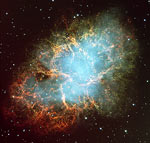The Death of Stars II: High Mass Stars
In February 1987 a new star appeared in the Large Magellanic Cloud, a neighbouring galaxy 170,000 light years away. What was remarkable was that this was the first naked-eye supernova (SN) visible since 1604. The object, named Supernova 1987A, was a massive star ripping itself apart in a violent event that released as much energy for a short period as the rest of the galaxy combined. Since observed extensively at all wavebands, SN1987A has helped astronomers better understand the death of massive stars.
Supernovae
Sanduleak -69° 202 was a blue supergiant with a mass of about 18 solar masses in the Large Magellanic Cloud. When it exploded as Supernova 1987A it captured the attention of astronomers from around the world. SN 1987A was a Type II supernova. These are massive stars, typically about 20 solar masses or higher, that explode, reaching luminosities of about 109 × solar luminosity or a magnitude of about -17 at maximum brightness for a few days before fading over several weeks. Identified by the presence of hydrogen lines in their spectra, Type II supernovae are thought to be due to the core collapse in massive stars as explained below. Massive stars basically live fast, die young and go out with a bang...
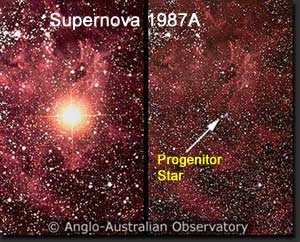
In the last stages of a supergiant when the core temperature reaches 1010 K, iron can photodisintegrate, releasing gamma photons, protons and He nuclei. As iron is energetically the most stable nucleus, such reactions absorb rather than release energy and so the outward pressure drops. The core thus contracts further at speeds reaching tens of thousands of kilometres per second. The degenerate core electrons eventually have sufficient energy to react with the protons released by photodisintegration. The reaction:
mops up all the electrons from the core. There is therefore no more electron degenerate pressure so the core collapse continues. Once the temperature reaches 1012 K the neutrons become degenerate. Neutron degeneracy pressure actually stops the inward collapse of the core. The surrounding material is still collapsing, however, and slams into the now solid, rigid core and rebounds, forming a massive shockwave. This is similar to what would happen if you run headlong into a wall - you bounce back. In the collapsing massive star the energy involved is vastly greater than you running in to a wall. A total of 1046 J is released in a matter of seconds, 50 × more than the Sun will release in 10 billion years on the main sequence.
Most of the energy released is actually in the form of neutrinos, only 1% is in the form of visible light. This, though, is sufficient for its luminosity to increase by 108, outshining the rest of the stars in a galaxy combined for a few days or weeks. Although neutrinos usually do not interact with normal matter the extreme density of the collapsing material and the high flux of neutrinos means that they, together with the shockwave, exert extreme pressure on the material collapsing onto the core and blow it off into space at speeds of about 5,000 km. s-1. Kamiokande II, a neutrino observatory buried deep below a mountain in Japan detected 12 neutrinos in February 1987 from SN 1987A. This was the first definitive detection of neutrinos with an event other than our Sun.
Type II supernovae occur in the arms of spiral galaxies. Typical rates for these explosions suggest that one should be visible in a galaxy every 25-50 years. None has been seen in our Milky Way since Kepler's supernova of 1604. Actually there is likely to have been several explode since then but they have been obscured by dust and gas in the galactic arms. The other main type of supernovae are the Type I, thought to be caused by thermonuclear explosions.
Type Ia supernovae have no detectable hydrogen line and a peak magnitude of -19 at maximum brightness. They are thought to occur in binary systems and are found in both elliptical and spiral galaxies. If an evolved white dwarf component star accretes material from a giant companion it can be pushed over the Chandrasekhar Limit of about 1.4 solar masses. This triggers a massive explosion that most likely destroys the star, ejecting large amounts of radioactive nickel. The nickel decays into cobalt and iron.
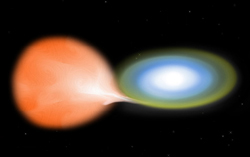
The extreme luminosity of supernovae means that they can be detected at large distances. Type Ia SNs have characteristically-shaped light curves that allow them to be used as probes of the Universe and its expansion rate. Two recent projects, the High-Z Supernovae Search and the Supernova Cosmology Project detected and observed supernovae in many distant galaxies. Both projects independently arrived at the conclusion that the Universe is actually accelerating.
Synthesis of Heavy Nuclei
We have already seen how elements up to the iron group are synthesised by fusion within some giant stars. Recall too how neutron capture via the s-process can build heavier nuclei in massive stars. How are the heaviest nuclei such as those of lead, gold and uranium produced? Fortunately the very last stages of a massive star provide an answer to this problem.
During the final destruction of the star in a supernova explosion, a high flux of neutrons is released as iron nuclei are ripped apart. These neutrons can be captured by many of the heavy nuclei to produce other nuclei in a method known as the r-process (r for rapid). The high number of neutrons available in these few seconds can be captured by unstable nuclei before the nuclei have had a chance to decay. In this way nuclei of elements such as lead, gold and all the way up to uranium can be synthesised. The gold in jewellery here on Earth was in fact formed during the fiery last seconds of a massive star. The destructive event not only creates new elements but provides the mechanism by which they are dispersed into space.
Supernova Remnants (SNRs)
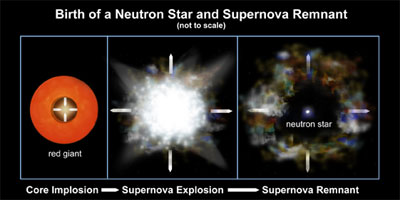
The material ejected from a supernova comprises hydrogen, helium and other elements synthesised in the star. Massive stars eject much of their material prior to the final explosion. This previously ejected material together with the ISM is then hit by a shockwave from the final explosion and the material ejected during it, forming a supernova remnant (SNR). The final explosion may propel matter at speeds of millions of kilometres per hour. When this material hits the earlier cloud it compresses it and heats up to 106 K due to the conversion of kinetic energy. At this temperature the SNR emits radiation at many wavebands.
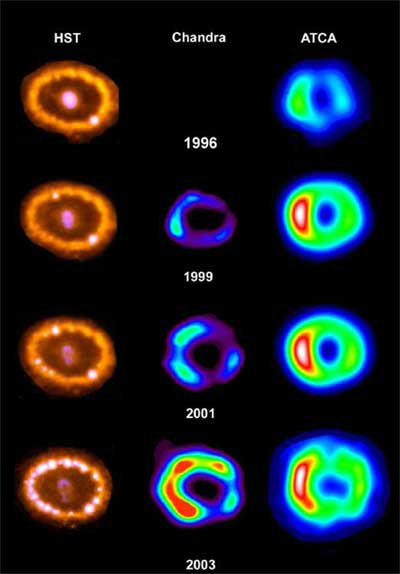
SNRs expand into space and may extend over tens of parsecs before they disperse into the ISM, normally within 100,000 years or less. Whilst the total amount of mass released into the ISM by a supernova may only be several solar masses the ejected matter is rich in heavy elements. This material can thus seed the ISM so that subsequent generations of stars will have higher metallicities than the original star that went supernova. The shock front from a supernova may provide the trigger for subsequent star formation in a molecular cloud. Optically, SNRs often have a greenish colour indicating the presence of oxygen ions.
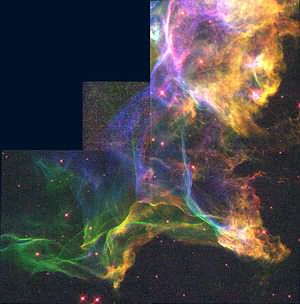
Some SNRs, such as M1, the Crab Nebula, (image at top of page) are powered by radiation emitted due to a pulsar embedded within it. They are thus continually re-energised by the synchrotron radiation emitted by high-energy electrons as they spiral around within the intense magnetic field of the pulsar. Such SNRs glow.
Hypernovae
Within the last few years astronomers have discussed another, even more powerful type of exploding star. Called hypernovae these are thought to occur when very massive stars undergo core collapse. They release vast numbers of gamma photons in the process with a total energy release of 10 - 30 × that of supernovae. The final product of such an event is likely to be a black hole with a mass greater than about 3 solar masses. Hypernovae are thought to be one source of Gamma Ray Bursts, GRBs. GRBs are enigmatic objects that produce extremely intense but short-lived bursts of gamma radiation. Astronomers have puzzled over them since the early 1970s when their existence was revealed following the declassification of US Air Force data. They were initially detected by satellites watching for nuclear explosions on Earth.
The spectra of the few hypernovae that have been optically detected reveal an absence of hydrogen and helium. This suggests that the star is so massive that it has fused all the available H and He into carbon and oxygen. SN 1998bw was the first example that matched the location of a GRB observed by the Italian BeppoSAX satellite. One model to account for the observations suggest that the explosion is constrained by intense magnetic fields into two beams rather the more common roughly uniform explosion in supernovae.
Neutron Stars & Pulsars
A massive star undergoing core collapse produces a Type II supernova. What happens to the core material that is not ejected depends on its mass. The photodisintegration of iron in the last stages of the massive star's life releases protons that in turn react with electrons to form neutrons (equation 6.3). These neutrons combine with existing core material to form neutron degenerate matter. Core collapse is halted by the degeneracy pressure of the neutrons if the mass is less than about 3 solar masses. The result is one of the most intriguing types of objects in the Universe, a neutron star.
Neutron stars are composed of degenerate neutron matter with a density about that of atomic nuclei, ∼ 1017 kg. m-3. A thimble-full of this material has a mass of almost 109 tonnes. They range in mass from a lower value equal to the Chandrasekhar Limit of 1.4 solar masses up to about 3 solar masses. This upper limit is not well-defined and may be up to 5 solar masses in some models. A neutron star is typically about 10 km across. We thus have a very exotic object with twice the mass of the Sun packed into a sphere the size of a small city! Due to the conservation of angular momentum, a neutron star spins at a high rate. Whereas a star such as the Sun rotates on its axis roughly once a month, a neutron star can rotate dozens of hundreds of times a second. This is analogous to an ice skater spinning faster as they draw their arms in close to their body.
The high rotational speed means that the surface of neutron stars are travelling at relativistic speeds. The gravitational pull on the material must be enormous to prevent the layer being ripped off. The acceleration due to gravity at the surface of a neutron star is of the order of 1012 m. s-2 compared with 10 m. s-2 at the surface of the Earth. Any material that falls onto its surface would thus be ripped apart and smeared one atom thick on the surface.
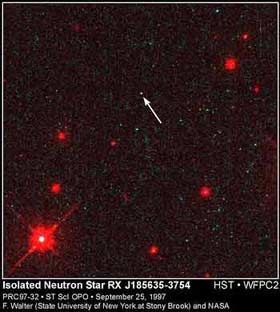
Being so small, neutron stars would also be very dim. There is no more fusion taking place so they can only radiate away stored heat slowly due to their small surface area. Only a few isolated neutron stars have been directly observed. There is, however, one type of neutron star that has been extensively observed. These are pulsars.
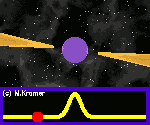
Pulsar stands for pulsating radio source. A pulsar produces two powerful beams of radiation. These beams arise due to the intense magnetic field possessed by neutron stars, ∼ 108 T. The axis of rotation of the pulsar is not aligned with the magnetic poles, just as our geographical and magnetic north poles are different on Earth. As it rapidly spins, one of the radiation beams may cut across the Earth's line-of-sight. A few pulsars have been observed at visible, gamma and X-ray wavebands but the vast majority of over 1,700 currently known have been discovered by radio telescopes, most by the 64-m Parkes dish.
Pulsars have very precise rotation rates which can be accurately measured. They are in fact more precise than the best hydrogen maser clocks on Earth. Given their extreme gravitational fields and high rates of spin they provide a useful test of of General Relativity. Some pulsars have been found in binary systems with other types of stars. The first-known double pulsar system, two pulsars orbiting each other, was discovered in late 2003 at Parkes and is proving of immense interest to observers and theorists.
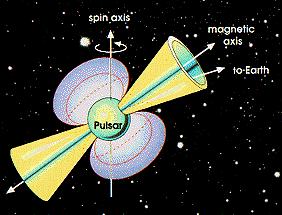
Perhaps the best known pulsar is lies at the heart of the Crab Nebula. It is the remnant of a star that went supernova in AD 1054. The Crab Pulsar is one of the few to be observed at visible wavelengths. High-speed shutters attached to a CCD allow astronomers to image the change in optical brightness as it spins.
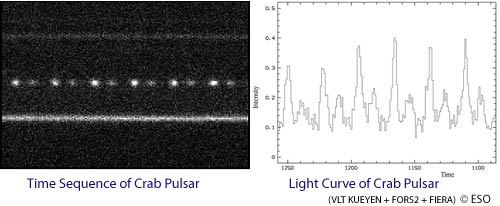
To find out more about pulsars, learn about their discovery and the ongoing research being carried out in Australia and overseas, visit our Introduction to Pulsars page on this site.
Black Holes
So far we have seen what happens to stellar remnants of about 3 solar masses or less. Remnants less than 1.4 solar masses become white dwarfs and will eventually cool down to black spheres of electron degenerate matter. Cores of 1.4 - 3 solar masses become neutron stars, 10 km spheres of rapidly spinning neutron degenerate matter. Young neutron stars may also be detected as pulsars if one of their beams crosses Earth. Sometimes though a star is so massive that the mass of the material left after all other mass-loss processes exceeds the limit that even neutron degeneracy pressure can withstand. At this stage then the material keeps collapsing inwards until all the mass becomes concentrated at a single point, a singularity. It is now a black hole.
Black holes are even more exotic objects than neutron stars. With all the mass concentrated at a point they have extremely high gravitational fields. They are referred to as black because not even light can escape from them once it has crossed a region known as the event horizon. At the event horizon, the escape velocity equals the speed of light, c. Black holes are therefore hard to observe because they do not emit light at any waveband. Rather than look for a black hole itself, astronomers infer their presence due to their effect on surrounding matter.
A black hole that is one component of a binary system may draw material off its nearby giant companion. As this falls towards the black hole it forms an accretion disk. The material in the accretion disk gets heated and so becomes ionised. Charged objects that get accelerated due to centripetal force emit high frequency synchrotron radiation. This is observed at UV, X-ray and Gamma-ray wavebands.
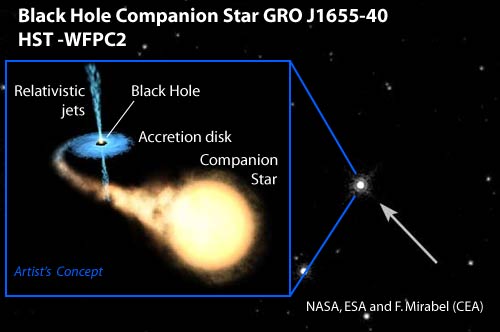
A black hole that is one component of a binary system may draw material off its nearby giant companion. As this falls towards the black hole it forms an accretion disk. The material in the accretion disk gets heated and so becomes ionised. Charged objects that get accelerated due to centripetal force emit high frequency synchrotron radiation. This is observed at UV, X-ray and Gamma-ray wavebands.
Black holes formed from core collapse of massive stars in hypernovae are thought to range in mass from about 3 to 15 solar masses. They are commonly referred to as stellar black holes so as to distinguish them from the supermassive black holes that are thought to lie at the centre of galaxies such as our own. These may range in mass from about 106 to 109 solar masses. Such supermassive black holes are likely to be responsible for phenomena such as active galactic nuclei (AGNs), Seyfert galaxies, BL Lacerate Objects and quasars or QSOs.
Some theories also predict the existence of primordial black holes formed during the Big Bang. Whilst still only theoretical in that none have ever been observed they would be very small - about the size of an atom but with a mass of 1011 kg.

